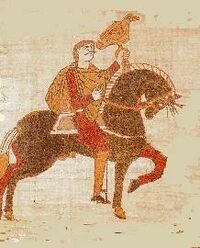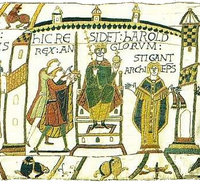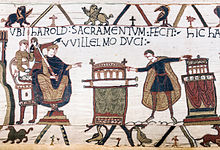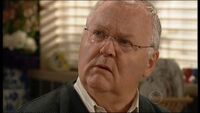Harold Godwinson
Harold Godwinson (c. 1022 – 14 October 1066) was the last purebred Anglo-Dane to rule England. For 10 short months, he was also known as King Harold, technically Harold II, as Harold I was already taken. He succeeded King Edward the Confessor (briefly fending off a challenge from Hugo the Hand-Wringer).
Unfortunately, his short time in the Chair was in an era when the kingdom was being invaded on all sides. He was replaced as monarch by William The Conqueror, the invader on the South side, who got not only the throne but several of Harold's extremities. Harold did not rule long enough to acquire a sobriquet of his own. But "King Harold the Brief" would have been apt.
At home with the Godwinsons[edit]
The Godwinsons were an important family of warlords who had risen to power under King Canute (he of the waves) under the leadership of Godwin the Goofball. When Canute died, Godwin backed Harold Hairy Feet as king (this was Harold I), and then King Halfcut of Denmark. When he ran out of Danes, Godwin backed Edward the Confessor. He married him off to one of his plainest daughters, as Edward was a card-carrying virgin. Far from expressing gratitude, Edward let it be known that he hadn't forgiven Godwin for torturing his brother Alfred to death.
Harold "Part Deux" grew up in this family. It wasn't always good. The family lost all the royal postings when Harold's elder brother Sweyn the Swine abducted a nun and raped her in his castle. King Edward briefly tried to be the actual king, rather than a lickable stamp look-alike, but then lost interest. The family were restored, but Sweyn was told to fuck off to the Holy Land and die. Which he did. Godwin died as well, making Harold the head of the family.
First Man of England[edit]

Harold was now essentially the Strongman of England. Whilst King Edward designed cathedrals and dreamt of potatoes, Harold went to war against the Welsh and helped organise the overthrow of Macbeth in Scotland. However, rivals at court were looking for a new "anti-Harold" to rally around.
King Edward seemed the last of his dynasty, until he received a postcard from Hungary from one Edward the Exile. He was a nephew of Edward the Confessor and wanted to "come home," learn English, and play cricket. Harold was alarmed.
In 1057, Edward the Exile arrived by long-distance horse-and-wagon from Hungary with his wife and family to meet "Uncle Eddie." Was Harry going to get the boot from government again? No; within days of arriving in London, Edward the Exile dropped dead. The Anglo-Saxon Chronicle (proprietor: Gyrth Godwinson, one of Harold's brothers) said the prince's sudden death was due to a fatal tummy bug brought on by eating good old patriotic English food after all the foreign muck he had lived on, back in Hungary. Since Edward the Exile's son Edgar was still fighting with his nurse when it came to diaper-changing, Harold would face no competition in that quarter.
Rather more of a threat was Edward's cousin, the thoroughly Norman French Wild Bill the Bastard, Duke of Normandy. He claimed Edward had promised him England when he was exile in Normandy to escape Canute. William had no evidence of this and visited London in secret to firm up the offer.
Under the quilts[edit]
Harold married two different women called Edith, a peculiar arrangement whose convenience proves itself any time you forget whose arms you are lying in tonight. One was Edith of Mercia, the other Edith with the Swan Neck Tattoo who was a whiz on the abacus. Since the painted Edith was low-class (but fertile), Harold crowned Edith of Mercia his consort when he became king in 1066. But the crucial question...had Harold broken any oaths over holy tombs to get there?
In one of the oldest surviving pieces of woven propaganda, the Bayeux Tapestry shows Harold swearing he would do anything to make William of Normandy the King of England. It's all there in brightly coloured threads. The story in the tapestry goes that Harold had invited himself over specifically to support William, but had landed in the wrong part of the French coast, in Ponthieu. The local count took Harold into custody, as his passport didn't cover visits outside Normandy. William bailed out Harold, who in return rendered military service for Normandy against neighbouring Brittany. Since Brittany was full of Welsh-speakers like on England's frontiers, William thought Harold would enjoy cracking more Celtic skulls. After Harold pledged his allegiance to William's cause, the Norman loaded Harold's boat back to England with a lot of stinky cheese, bottles of cider, and "a few French fancies."
King by acclamation[edit]
King Edward the Confessor died in January 1066. Though his will designated Willy the new ruler, the nobility met and "acclaimed" Harold as king instead. This brushed aside not only the claims of William but those of Edgar the Colicky (son of Edward the Exile) and King Sweyn of Denmark (a nephew of Canute). Another surprise challenger was the Viking killing machine Harald Harderbastarder of Norway. He said King Halfcut had made a deal over a game of chess that whoever died first would hand over his lands to the other. Harald had won the bet and, after long service as an Imperial bodyguard for Byzantine rulers, he was ready to collect his prize.
Harold secured Edgar first, locking him in Westminister Abbey on extended detention. King Sweyn of Denmark let others take their chance against Harold. In contrast, Harald Harderbastarder ordered a lot of timber to build an invasion fleet, whilst William looked for supplies on the black market.
Three invasions[edit]
Harold's younger brother Tostig had proved himself as big a calamity as the unlamented rapist Sweyn, that other black sheep of the Godwinson family of black sheep. Tostig had become Earl of Northumbria but governed so brutally that the locals rebelled and Harold would not rehabilitate him. Tostig deserted Harold for Harald, leaving for Norway to fight on the other side. In Normandy, William prepared to invade England, but 1066 was a bad year for South wind. For months, his ships kept leaving harbour only to be blown straight back in.
Harold saw William as the bigger threat and kept his army there, expecting others to look after the North of England, which others did not. Harald Harderbastarder, now with Tostig at his side, sailed from Norway and landed their army near York. The English forces in the area offered battle and got their English asses handed to them at the Battle of Fulford. Down South, Harold broke camp and, four bonfires later, arrived in York.
The year 1066 thus saw the English side lose in the regular season but back its way into the playoffs, winning at the Battle of Stamford Bridge. This was an unusual battle, as ambiguous tactical direction such as, "Regroup around Harald!" resulted in chaos. Harderbastarder's parrot mascot was killed and the the bright blue kit of the English army dazzled the eyes of the sun-starved Vikings. The air also turned blue, with mutual curses and anatomical figures of speech, until first Harald and then Tostig the Traitor died in combat with their English enemy.
England advanced to the second round, but King Harold had left the back gate open. The wind changed and William was in England with his soldiers.
Harold marched his men back south, where they met William's forces in the sleepy Sussex town of No Name. The conflict was named after the local seaside resort of Hastings. No Name town was originally called "Battle of Hastings Theme Park," but over time it simply became "Battle."
But you cannot dazzle Frenchmen by dressing more foppishly. Harold died with an arrow in his eye and a broadsword to the belly. So mangled was his body that Edith with the Swan-Neck-Tattoos was brought to the battlefield to identify her ex-lover. The key was a secret tattoo on his scrotum that read (in Old English), "Bollocks to Norman Bastards." William thanked Edith and exiled her, because England had now moved from an Anglo-Dane monarchy into French management. Harold's body was thrown into a pit, but was later reburied at Waltham Abbey.
Legacy[edit]
The anniversary of Harold's death became a Norman French national holiday. This carried on until Chaucer's day, in the late 14th century. It was only in the late 18th century and early 19th century that it came back into vogue. Harold became an archetypical English hero: bearded and brave, but a total loser.
| Preceded by: King Arthur |
Protector of the British Isles 1066 |
Succeeded by: William The Conquerer |



